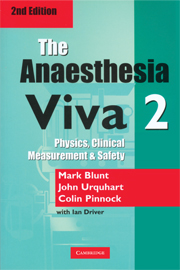Book contents
- Frontmatter
- Foreword to the First Edition
- Preface to the Second Editions
- Contents
- Physics, Clinical Measurement & Safety
- Clinical Anaesthesia
- Example 1
- Example 2
- 6 Example 3
- 7 Example 4
- Example 5
- Example 6
- Example 7
- Example 8
- Example 9
- Example 10
- Example 11
- Example 12
- Example 13
- Example 14
- Appendix 1
- Appendix 2
- Index
Example 13
Published online by Cambridge University Press: 05 February 2015
- Frontmatter
- Foreword to the First Edition
- Preface to the Second Editions
- Contents
- Physics, Clinical Measurement & Safety
- Clinical Anaesthesia
- Example 1
- Example 2
- 6 Example 3
- 7 Example 4
- Example 5
- Example 6
- Example 7
- Example 8
- Example 9
- Example 10
- Example 11
- Example 12
- Example 13
- Example 14
- Appendix 1
- Appendix 2
- Index
Summary
Scenario
The first patient on your gynaecology list (for hysteroscopy) tells you she is allergic to latex. What do you know about latex allergy?
This is a general question that can be answered with a general overview. It is likely, however that the questioning will proceed on to the precautions necessary when anaesthetising latex sensitive patients.
You should begin by saying that allergy to natural rubber latex is an increasing problem for health care workers who may have to carry out procedures on patients who react to latex or who may themselves develop reactions to latex. The reactions tend to fall into two groups, either skin contact or anaphylactic in type. Both are serious problems and no distinction should be made between them.
Natural latex contains a variety of highly allergenic proteins, which cause reaction by repeated exposure and hypersensitivity. Continued exposure increases the severity of the reaction. It is interesting that there are reports of cross-reactions to similar proteins in fruits such as banana, avocado and kiwi fruit as well as nuts.
If a patient reports possible latex allergy then, while skin testing by dermatologists is possible, it is time consuming and potentially dangerous so it may be wise to accept the patient at face value and treat them as if they are positive. Many latex sensitive patients will have a history of skin reactions to rubber gloves, condoms or balloons.
- Type
- Chapter
- Information
- The Anaesthesia Viva , pp. 123 - 125Publisher: Cambridge University PressPrint publication year: 2003



